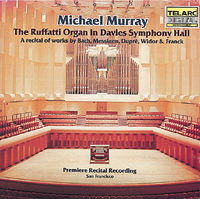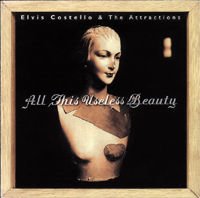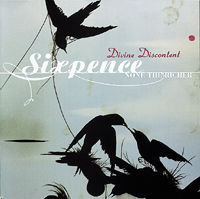| Columns Retired Columns & Blogs |
The Fifth Element #25 Page 2
Binding posts of Wilson Benesch's own design, at the lower rear, provide for biwiring. Jumpers are provided for single-wiring, and high-quality wrenches for the spike nuts and binding posts. The spikes, nuts, wrenches, owner's manual, and jumpers come packed in a small plastic attaché case. The A.C.T.s' shipping cartons, by the way, are exemplary. Three large quarter-turn latches on an overlapping flap make them the first loudspeaker cartons I have ever seen that are reusable without packing tape. (Engineering elegance aside, I assume that having a carton that can be easily opened and closed for customs inspection is a rational concession to our post-9/11 realities.)
Footnote 1: Copyright 2002 Squint Songs and My So-Called Music, all rights reserved. And ya just gotta love the first verse's T.S. Eliot allusion.
 The A.C.T.'s standard finishes are silver and black. An upcharge applies to wood finishes in satin natural cherry, maple, and oak, or high-gloss stained red cherry, bird's-eye maple, or walnut burl. The high-gloss woodwork is crafted by the same firm that provides dashboards for Anglo-German luxury automaker Bentley. Other loudspeakers have industrial design and fit and finish of about the same quality as Wilson Benesch's, but I can't think of one that surpasses.
The A.C.T.'s standard finishes are silver and black. An upcharge applies to wood finishes in satin natural cherry, maple, and oak, or high-gloss stained red cherry, bird's-eye maple, or walnut burl. The high-gloss woodwork is crafted by the same firm that provides dashboards for Anglo-German luxury automaker Bentley. Other loudspeakers have industrial design and fit and finish of about the same quality as Wilson Benesch's, but I can't think of one that surpasses.
Listening to the A.C.T. has been an immensely enjoyable experience. Some loudspeakers seem to bring out the neurotic audiophile in just about anyone, but Wilson Benesch is as far from that vibe as one can get. The speakers seem to say, "Please just sit down and enjoy the music." The A.C.T.s were not "euphonic." They just got it satisfyingly "right."
There were no surprises in my listening sessions, just a renewed sense of recognition of the music. The A.C.T. sounded as you would expect: much like the A.C.T. One and Two, but with the work on refining the concept having yielded obvious improvements.
The new Wilson Benesch A.C.T., although quite reminiscent of its predecessors, reached a new level of magical organicity and seductive coherence. Their sonic presentation embodied near-electrostatic clarity of detail without ever sounding etched, tipped-up, harsh, or in any way unmusical. The A.C.T.s' imaging and soundstaging were just short of staggering; from time to time, the speakers really did seem to disappear.
Memory is fallible, but the new A.C.T. might make the One sound slightly euphonic in the upper midrange, such as on Ella Fitzgerald's Easy to Love (CD, Verve 821 990-2). The A.C.T. also had even less of a sense of "boxiness" than the older speakers, and that is quite an achievement. Dispersion was excellent; there was no sense of horizontal or vertical constriction. Image height, width, and depth were superb.
I did have the impression of substantially more bass fullness with the new speaker. To say the least, it did not fall down on the job with organ recordings, both my own and ones from other labels, such as Michael Murray's inaugural recording of the Ruffatti organ at San Francisco's Davies Symphony Hall (CD, Telarc CD-80097). The A.C.T. rose to the occasion of Bach's textbook organ fugue "Kyrie, Gott heiliger Geist," BWV 671, with a thrilling display of power.
 Admittedly, though, a speaker that is flat at 28Hz and has output below 20Hz will always have the ultimate advantage in terms of visceral impact on organ recordings when compared to a speaker, such as the A.C.T., that begins to roll off right below 40Hz. Partially compensating for its lack of deepest bass, the A.C.T. could play seriously loudly without any sense of strain, through the use of the Tactic drivers. WB claims 111dB are available at 1m. I'll have to take that on faith, but the old garage-door track on the first Hi-Fi News & Record Review Test Disc (CD, HFN/Denon 003) was arresting.
Admittedly, though, a speaker that is flat at 28Hz and has output below 20Hz will always have the ultimate advantage in terms of visceral impact on organ recordings when compared to a speaker, such as the A.C.T., that begins to roll off right below 40Hz. Partially compensating for its lack of deepest bass, the A.C.T. could play seriously loudly without any sense of strain, through the use of the Tactic drivers. WB claims 111dB are available at 1m. I'll have to take that on faith, but the old garage-door track on the first Hi-Fi News & Record Review Test Disc (CD, HFN/Denon 003) was arresting.
Other favorite tracks through the A.C.T. were John Atkinson's recording of Cantus singing "Shenandoah" (CD, Cantus CTS 1201), Ensemble Amarcord singing "Juramento" (CD, apollon classics apc 10102), and the pizzicato-scherzo movement from Ravel's string quartet, played by Nuovo Quartetto (CD, Denon 33C37-7830, NLA).
This is as good a time as any to recommend that you check out (but not necessarily wholeheartedly embrace) Sixpence None the Richer's second major-label album, Divine Discontent (CD, Warner Bros. 886010). I have enjoyed the journey into the sonic and philosophical world of this record, despite having a couple of reservations. First, Leigh Nash is doubtless a very fine person, but her singing voice is a bit raspy and somewhat wavery—not quite out-and-out annoying, but not rapturously beautiful, either. Second, most of the tracks, by which I mean the individually recorded channels of music or vocal that were mixed to assemble the complete "track," do seem to have been dynamically compressed a bit too much, perhaps in an effort to make the finished product sound punchier on a car radio.
Nonetheless, this disc contains two or three truly exceptional songs. Sixpence's remake of Crowded House's "Don't Dream It's Over" is good clean fun, while their original "I've Been Waiting" is poignantly confessional. That song, addressed to a lover human or divine, has the refrain: "So I'm changing who I am / 'cause what I am's not good / And I know you love me now / But I don't see why you should." (footnote 1)
 However, if you want an object lesson in what separates well-intentioned neophytes from true artists, move from Divine Discontent to Elvis Costello's magnum opus of rage barely held in check, All This Useless Beauty (CD, Warner Bros. 46198). Apart from the essential musical value of the songs and the singing, the production values and added sounds are almost a history of making records, and of musical styles.
However, if you want an object lesson in what separates well-intentioned neophytes from true artists, move from Divine Discontent to Elvis Costello's magnum opus of rage barely held in check, All This Useless Beauty (CD, Warner Bros. 46198). Apart from the essential musical value of the songs and the singing, the production values and added sounds are almost a history of making records, and of musical styles.
The first song includes the lines "as I sit here moping / With a bamboo needle on a shellac of Chopin." Later in the album you hear DJ-style scratching, and a panoply of production tricks that harks back to the dawn of "concept albums" such as Pet Sounds. Peter and Gordon, take a bow.
Elvis C. might not be everyone's cup of tea—listening to this album straight through might make one question whether Diana Krall really had any idea what she was getting into when she married him, though I guess that's none of our business—but if I had to pick one rock record that was the spiritual equal of Fitzgerald's The Great Gatsby, All This Useless Beauty would be it.
I drove the A.C.T. with Plinius' 9200 integrated amplifier, both on its own and as a preamplifier for the darTZeel NHB-108. As far as I'm concerned, the Plinius is the bargain champ in amplification. For a lot more money, the darTZeel amplifier is a wonderful complement to the A.C.T.'s bred-in-the-bone musicality. Stereovox, Nordost Valkyrja biwire, and Wireworld Super Eclipse 5 biwire speaker cables all sounded wonderful—any preference was both amplifier-dependent and a matter of personal taste. With the Plinius integrated, it was the Wireworld by a nose; using the darTZeel, it was the Nordost by a nose.
The A.C.T.'s published impedance curve is quite benign, averaging 6 ohms and not falling below 4 ohms. Sensitivity is claimed to be 88dB. I've heard reports from the field that the A.C.T. works very well with tube amplifiers, even low-powered ones (by which I mean 20Wpc or so rather than 3Wpc).
The one point on which Wilson Benesch speakers have sometimes come in for criticism in the US press has been their handling of the very bottom octave. To avoid misunderstandings, midrange means having to do with middle C (262Hz) and the octaves on either side; 131Hz or thereabouts (eg, 140Hz) is thus a plausible dividing line between lower midrange and upper bass. An electric bass guitar's low E is 41.2Hz. I would therefore posit 40Hz as the dividing line between "bass" and "low bass." This makes sense, given that 20Hz, the pitch one octave below 41.2Hz, is generally regarded as the limit of human hearing's pitch sensitivity.
As far as landmarks go, below E at 41Hz there are the notes D at 36.7Hz, C at 32.7Hz, B at 30.8Hz, and piano low A at 27.5Hz. Below piano low A there are only the additional bass strings of a Bösendorfer Imperial Concert Grand piano, organ pipes, percussion, sound effects, and synthesizers.
My impression was that the A.C.T. was flat at 41Hz and obviously lacking at 20Hz. I estimate that in my room it was down about 6dB at 28Hz—in other words, half as loud as at 41Hz. To put this in perspective: Unless you listen almost exclusively to organ or the largest symphonic works, I doubt that the A.C.T.'s comparative lack of low-bass extension will be much of an issue. (If your listening setup does double duty as a home theater, this is probably a nonissue; filling in the octave from 20 to 40Hz is what subwoofers are made for.) The A.C.T. was flat at electric-bass low E and tremendously punchy on bass drum. In a word, it was a fantastic speaker for rock music.
I imagine it would have been possible for Wilson Benesch to get more bass extension out of the A.C.T., but (I assume) only at the cost of over-porting the enclosure, thereby running the risk of "one-note bass." Keeping in mind the ever-present, serpent-in-the-garden temptation upon audio designers to design their products to be impressive during a brief showroom audition rather than building them to be appreciated and enjoyed over the long haul: at the end of the day, limited low-bass extension is, in my book, preferable to boomy bass, or bass with poor pitch definition.
If you want more bass extension than the A.C.T. can provide, Wilson Benesch's Chimera, at $20,900/pair, offers a larger cabinet with two pairs of isobaric woofers and a passive bass radiator. The added bass drivers result not only in more bass extension (their published -6dB point is 25Hz, compared to the A.C.T.'s published -6dB point of 32Hz), but also better coupling to the room, and a greater sense of heft, authority, and dynamic ease.
To sum up the Wilson Benesch A.C.T.:
Pros: Drop-dead gorgeous; extraordinarily low distortion; tonally seamless and coherent; superlative soundstaging; room-friendly and easy to set up; powerful yet nuanced dynamics.
Con: Although the new model's improved bass is excellent—very quick, very clean, and powerful—larger and more ambitious speakers will do a better job with the lowest octave.
If you're shopping for loudspeakers in the $12,500/pair range, you're doing yourself a huge disservice if you don't audition the A.C.T. I haven't heard another speaker in its price tier that I prefer.
If you're not shopping in that range, you probably should hear the A.C.T., just so you can have an idea of what is possible in the, at times, seemingly absurd quest to reproduce some of humankind's highest aspirations using coils of wire attached to domes and cones.
Verdict: Class A, Restricted Extreme LF.
Footnote 1: Copyright 2002 Squint Songs and My So-Called Music, all rights reserved. And ya just gotta love the first verse's T.S. Eliot allusion.
- Log in or register to post comments




































